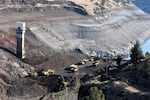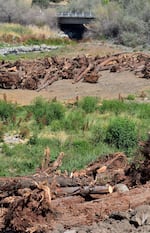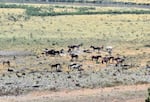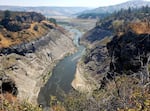
Scoop by scoop, crews from construction company Kiewit are deconstructing the massive earthen barrier that was Iron Gate dam, July 26, 2024.
Juliet Grable / JPR
A new landscape and river are emerging in the Klamath Basin.
Iron Gate dam is disappearing. One of three barriers being removed from the Klamath River in far Northern California and Southern Oregon this summer, the dam once stood 173 feet tall. Now it’s about a third of its original height.
On a Friday in late July, a dozen bright yellow machines crawled across what was left of the dam. An excavator bit into a pile of brown earth, then hovered its claw over a waiting 40-yard dump truck; three giant scoops and the truck was full. The driver beeped twice, and the truck chugged away, only to be replaced by another one.
From an overlook southwest of the dam, the machines looked like Tonka toys in a sandbox.
“The trucks look so tiny from here, but the wheels are taller than I am,” said Ren Brownell, public information officer at Klamath River Renewal Corporation, which is overseeing dam removal.
Completed in 1962, Iron Gate was constructed with approximately 1 million cubic yards of earth and rock. It will take 25,000 truckloads to remove it all.
Related: The Klamath River’s Iron Gate comes down, one scoop at a time
Crews have already used some of the material to bury the concrete spillway on the north side of the dam; now, they’re delivering loads to the “borrow pit” southeast of the dam — the same place from which the earth was first extracted over 60 years ago.
Upstream, the concrete arch dam that was called Copco 1 is all but gone, as crews work to remove a portion of the concrete foundation below the riverbed. And in Oregon, J.C. Boyle dam has been completely dismantled.
“We’re very ahead of schedule at this point,” says Brownell — good news for Chinook salmon that might venture from the Pacific Ocean past Iron Gate on a historic return as soon as this fall.
Preparing the way for salmon
Several miles upstream of Iron Gate, Jenny Creek winds under a bridge and through the former reservoir footprint. Just a year ago, the creek turned into a sluggish pool clogged with bright green algae as it spilled into the Iron Gate reservoir; now, it’s tumbling freely over boulders and past young willows that have sprouted along the banks.
Cool, spring-fed streams like Jenny Creek are crucial refuges for Klamath River salmon, says Mike Belchik, senior fisheries biologist at the Yurok Tribe. “The Klamath River was always a warm water system in summer, and fish have strategies for dealing with that, mostly involving the use of tributaries,” he says.
With the dams gone, salmon will be able to dart past warm sections of river and into these cool pockets for the first time in over 100 years.
Related: Commercial salmon fishermen eye Klamath dam removal with cautious hope
Crews with the contractor Resource Environmental Solutions, or RES, are restoring Jenny Creek and four other high-priority tributaries in the reservoir footprints to more natural conditions in anticipation of the salmon’s return. Several dozen large logs with intact root masses are stockpiled near Jenny Creek; later this month, helicopters will place the trees along the streams.
Director of Fisheries, Aquatics & Design at RES, Dan Chase, says the wood will help create “instant habitat” by catching gravel and form pools and cover for small fish and bugs. “We’re excited to get that wood out there this summer, so that over the winter and next spring, as flows from those tributaries interact with the wood, it helps to start shaping more of that habitat,” says Chase.
A new landscape emerges

Logs set aside for creek restoration by Resource Environmental Solutions, July 26, 2024.
Juliet Grable / JPR
With help from tribal crews, RES has also completed the first phase of revegetation in the reservoir footprints. The monumental effort involved broadcasting 65,000 pounds of native seeds and planting over 78,000 shrubs and trees and 27,000 acorns by hand.
Earlier this summer the newly exposed mudflats blushed with color as plants germinated and bloomed; now, it’s drying and dying back in the summer heat.
“That’s part of the process,” says Chase. “A lot of those native plants will then start to produce their own seed.”
In some areas, particularly on the north side of the river in the Iron Gate reservoir footprint, free-ranging horses have grazed, trampled, and uprooted the new vegetation and imported seeds from non-native plants on their hooves and in their poop.
“You can really see that at Jenny Creek, where there’s been quite an impact from free-range grazing,” says Brownell.
National conservation advocacy group Trout Unlimited has begun fencing the Iron Gate reservoir footprint, starting with the north side where the most damage has occurred. Evan Bulla, Klamath River project coordinator at Trout Unlimited, has seen a significant uptick in the number of horses using the area.
“Last year, you could see maybe 30, 40 horses at a time. Now there’s over 100 permanently camped in the reservoir, chewing on that vegetation and drinking the water,” says Bulla.
Related: No turning back: The largest dam removal in US history begins
Siskiyou County has an open range law, which means it’s up to the individual landowner to keep out unwanted livestock. The “wildlife friendly” fencing TU is installing will thwart horses and cows but allow adult deer to jump over it and fawns and smaller mammals to crawl underneath. Horses and cows will still be able to access water at tributary creeks.
The fencing won’t just keep out livestock, says Bulla. It will also protect any cultural resources like village sites and artifacts in the reservoir footprints. At J.C. Boyle in Oregon, about seven miles of fencing will keep ATVs from tearing up new plantings.
RES will begin another round of planting this fall, says Chase. “We’ll be going back year after year to make sure we get the coverage and hit the performance criteria” set forth in their contract.

Horses grazing along the banks of the Klamath River, July 26, 2024.
Juliet Grable / JPR
Water quality recovers
On July 30, dam removal advocates marked another milestone at J.C. Boyle dam in Oregon when the cofferdam, a small dam behind the main structure, was blasted away. The cofferdam was used to divert the river through the spillway while crews deconstructed the dam. Representatives and elders from the Klamath Tribes and Modoc Nation came to witness the moment when water broke through and rejoined the river downstream.
Further down, at Iron Gate, the river is still being routed through a 14-foot tunnel at the base of the dam while crews work to remove the rest of the earthen barrier.
“When we do break the [Iron Gate] cofferdam, that will send another pulse of sediment downstream,” says Brownell. This event won’t be nearly as dramatic as when water was first drained out of the three reservoirs in January of this year.
As expected, the drawdown released an enormous load of fine silt and dead algae that had built up behind the dams. The material turned the water a dark muddy brown, and dissolved oxygen levels temporarily dipped.
Related: Klamath River water improving, according to California water board
Testing commissioned by Siskiyou County in January showed levels of certain heavy metals rose above drinking water standards. In March, the Siskiyou County Board of Supervisors declared a state of emergency over water quality concerns. On May 21, the Board extended the emergency.
KRRC says water quality testing they commissioned in early May showed that levels of several metals of concern, including aluminum, iron, arsenic, and lead, had dropped. Scientists from Camas, the testing agency, and an independent expert, Jacob Kann, concluded that the Klamath River is safe for recreation and agricultural uses, and that it can be used as a “raw water source” for drinking water systems, so long as the water is filtered and treated.

The Klamath River as viewed upstream from an overlook near the Copco 1 dam site, July 26, 2024.
Juliet Grable / JPR
Since drawdown, the river continues to alternate between clear and murky, depending on how flows are managed upstream. Belchik, the fisheries biologist, has been carefully tracking temperatures along the river since drawdown. “I’m looking for any evidence that we’re going to be cooling down in the fall, and I’m seeing it,” says Belchik.
Historically, the Klamath River always cooled “from the top down,” he explains. The river starts in Upper Klamath Lake, then cools down in the upper reaches thanks to contributions of chilly water from natural springs and tributaries. But the three reservoirs on the Klamath River disrupted this pattern by acting like huge batteries, storing and slowly releasing heat. As a consequence, the river below Iron Gate dam stayed unnaturally warm into the fall, which delayed the fall run of Chinook salmon by about three weeks.
This summer, with the reservoirs gone, the lowest nighttime temperatures on the entire Klamath River are at Iron Gate, “by a long ways,” says Belchik.
Related: Checking in on the next phase of Klamath dam removal
These cooler temperatures bode well for future runs of fall Chinook, which could be lured upriver sooner.
Early running fish can reap a “huge evolutionary reward,” explains Belchik. “If you’re the first one up there, the first one to spawn, your eggs hatch first; your young are bigger because they start growing earlier.”
Growth equals survival, he adds. “Big fish survive better than small fish, straight up.”
As much as the removal of the physical barriers and the transformation of the landscape from mud-grey to electric green, the return of salmon will mark a true sign of healing in the effort to reconnect the Klamath Basin ecologically and culturally.
The scale of the restoration will be visible from space, adds Belchik. “It’s something that you can see that will change the map, and that will change the future of the Klamath Basin.”